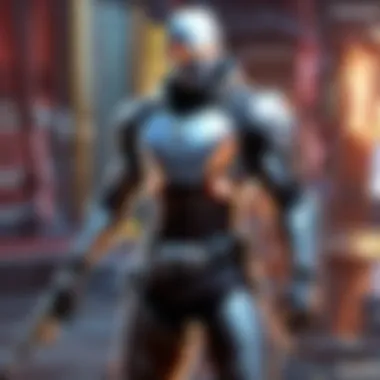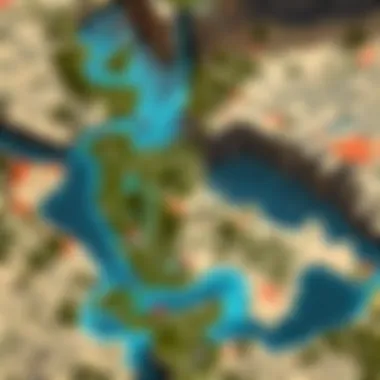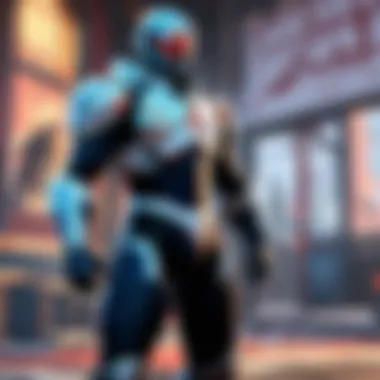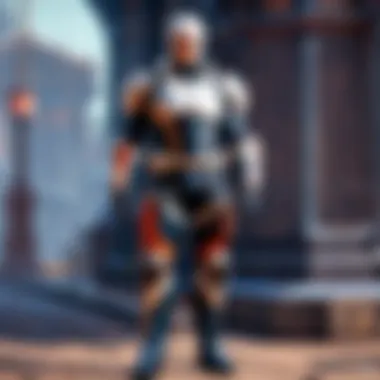Valorant Strategies: Mastering Act 2 for Victory


Game Overview
Intro
Valorant has emerged as a critical player in the competitive gaming landscape. Released by Riot Games, this tactical shooter has blended elements from various genres to carve out a unique niche. Understanding how to navigate its complex layers is vital for both casual gamers and competitive players.
Intro to Valorant
In Valorant, players engage in team-based combat where they choose from unique agents, each equipped with specific abilities. Unlike other first-person shooters, the agent's skills introduce depth to strategy, setting the game apart.
Game mechanics and objectives
The primary objective within matches is to either plant or defuse the Spike while eliminating opposing players. This dynamic creates a consistent back-and-forth that keeps every match engaging and high-stakes. Precision shooting is essential, but the importance of each agent's abilities adds a layer of tactical depth.
Brief history of the game
Valorant was initially released in June 2020. The transition from closed beta to full release came with robust community feedback offering a wealth of criticisms and suggestions. This phase set the stage for continuous evolution. The developers prioritize engagement with the gaming community and regularly implement changes based on player feedback.
Playable agents and their unique abilities
Valorant hosts a diverse roster of agents. Each of these characters possesses their unique abilities. Understanding these can streamline strategies within the game. In Act 2, players will benefit from a keen knowledge of these agents:
- Duelists like Reyna and Phoenix excel in aggressive plays, prioritizing offense.
- Controllers such as Brimstone and Viper shape battlefield dynamics, controlling spaces effectively.
- Initiators, for example Sova and Jett, disrupt enemy strategies with their unique detection abilities.
- Sentinels, including Sage and Cypher, focus on defense and support, ensuring team survivability.
Strategy Guides
Next, we will dive into essential strategies. Both new and experienced players can refine their gameplay through fundamental tips, advanced tactics, and an understanding of map principles.
Prolusion to Act
Understanding Act 2 is crucial for any player engaged with Valorant. This section acts as a bridge to explore significant gameplay changes and mechanics introduced since the start of this act. Both casual gamers and competitive players can benefit from a solid grasp of the alterations in dynamics that come with Act 2. It is essential to recognize how these changes impact strategies, player choices, and overall game performance.
Overview of Act Dynamics
In Act 2, Valorant continues its evolution, presenting challenges and opportunities shaped by various factors. Map design plays a pivotal role in mechanics, impacting sightlines and engagement zones. Players must adapt not just to evolving meta strategies, but also to changes in agent abilities.
Because the strategy varies with each act, an awareness of the dynamics sets a foundation for optimizing gameplay. Mechanics prices weapons differently and adjusts various aspects within maps providing a nuanced experience. Moreover, understanding team composition can bridge the gap between individual performance and collective success.
The Significance of Act
The significance of Act 2 in Valorant cannot be overstated. It is not merely about gameplay alterations. This act threads deeper into player interactions and the competitive landscape. With updated gameplay mechanics and agent introductions, players face new challenges and have access to fresh tactical options uplifting the competitive fun.
Moreover, for professionals, approaching competitions during this act means heightened awareness of opposing team strategies. Each game must be approached with flexibility and foresight, allowing teams to leverage their individual strengths effectively while addressing enemy plays.
This act serves as the benchmark for future updates as well. By observing player responses and forming strategies around feedback, developers obtain insight, shaping future acts and ensuring long-term engagement within the community. Players who understand these underpinnings can significantly influence average gameplay quality and their tactical performances.
Key Changes in Act
Act 2 of Valorant introduces pivotal changes that can shape player experiences and strategies. Understanding these modifications is essential for both casual gamers and competitive players. With adjusted characters, revamped maps, and altered game mechanics, players equipped with this knowledge can navigate the complexities of the game with updated techniques.
Agent Adjustments
New Agent Prologues


New agents bring fresh dynamics to gameplay. These introductions often provide different abilities and styles. In Act 2, we see the emergence of KAY/O, an initiator who disrupts opponents with a unique kit that includes a flash and a skill to suppress enemy abilities. This characteristic is significant in high-stakes matches, as any loss of enemy abilities can affect their gameplay trajectory. Thus, KAY/O becomes a valuable choice for optimizing team compositions. Players who utilize this agent tend to gain a competitive edge, particularly in controlling the map and pressuring opponents.
Balance Changes to Existing Agents
With each act, adjustments are also made to existing agents. During Act 2, adjustments affected characters like Jets, who saw minor tweaks in her abilities. Understanding these changes can highlight the tactical advantages gained from implementing her revised skills effectively. For players, this means adapting to altered timings and ranges responsibly. Recognizing the impacts of these adjustments can dictate response strategies during critical moments, making as much difference in individual performance as the careful handling of agent synergy.
Map Tweaks
Modified Layouts
Changes in map layouts introduce new routes and strategies. For example, in Bind and Haven, certain sightlines have been altered, leading to different control dynamics. These modifications require players to rethink common approaches to maps. Adapting to modified layouts not only enriches tactical variety but also affects team strategies significantly. Teams can gain from effectively leveraging these changes to block enemy pushes while maintaining ideal coverage.
New Tactical Opportunities
With every alteration, fresh opportunities often arise for clever plays. For example, Split now features enhanced vertical aspects, presenting increased possibilities for flanking maneuvers. These new tactical opportunities provoke shifts in player strategies, encouraging innovative ways to surprise opponents. Embracing creativity can yield benefits, especially during tight matches when a single unexpected play can turn the tide.
Mechanics Revisions
Weapon Adjustments
Gameplay mechanics regarding weapon handling can alter how matches unfold. With intermittent tweaks to individual weapons in Act 2, including adjustments to precision and damage fall-off, players are offered fresh layers to explore. This invites players to reassess their preferred loadouts and playstyles. Knowledge of these weapon adjustments proves beneficial, allowing players to adapt to shifts effectively and utilize firearms optimally.
Changes to Economy Systems
Economic alterations in Valorant’s system also present considerable influencing factors. Adjustments affecting costs of Agents and strategies relating to buy phases might compress the pacing of matches. Understanding these changes can provide insights into when to save or force a buy, impacting long-term match success. More specifically, recognizing shifts related to early round investment can unlock avenues for resource maximization, fundamentally shifting team economy management. > "Embracing the economic landscape is as vital as understanding bullets and abilities."
These key changes in Act 2 potentially recalibrate how players will structure their gameplay. Adapting proficiently to these adjustments can lead any savvy player closer toward achieving mastery and refresh their engagement with Valorant.
Strategic Approaches in Act
Utilizing strategic approaches in Act 2 of Valorant is fundamental for both casual gamers and competitive players. Effective strategies can make the difference between winning and losing. It focuses on essential elements like team composition, map tactics, and adaptability to evolving game dynamics. Employing a thoughtful strategy allows players to gain an upper hand over their opponents while enhancing their gameplay experience.
Team Composition Strategies
Balancing Roles Effectively
Balancing roles is crucial for assuring that a team operates in harmony. It creates a well-rounded group where each player contributes according to their strengths. Typically, a good balance of Duelists, Controllers, Initiators, and Sentinels ensures coverage. The key characteristic here lies in forming a blend rather than fixing rigid roles.
A popular choice in this section often revolves around team synergies. Every team member should complement each other. For example, a Duelist can take risks, allowing a Sentinel to secure entries or defend territories confidently. The disadvantage might come from an unrealistic expectation when a team does not effectively utilize roles leading to team disarray and inhibiting success.
Utilizing Diverse Abilities
Diverse abilities within a team enhance prowess to adjust to various encounters. Choosing agents from different classes to tap into their unique skills is vital. Every agent offers abilities that can greatly impact gameplay. They might offer reconnaissance, healing, or area denial.
An example is having Sova for scouting and Sage for healing in a lineup. Such diversity encourages players that engage directly or need support. Still, managing abilities can be challenging. Often, players must strategize when to use them effectively, therefore making it essential but potentially demanding.
Map Control Techniques
Effective Use of Utilities
The effective usage of utilities empowers players to control the game. These utilities come in forms like grenades, smokes, and flashes, playing pivotal roles in engagements. They manipulate interests to capture objectives and maintain control calmly.
Recognizing how to effectively use these tools amplifies tactical advantages. For instance, using smokes provides eyesight and creates opportunities for team movements. While there are great advantages while using these utilities, over-reliance could lead a team to waste critical resources and expose them if failed, thus some caution warned.


Controlling High Ground
High ground is often a key area that roughly determines the flow of gameplay. Controlling elevated spaces offers a considerable edge, as it provides a wide visibility range and other tactical advantages.
This feature holds increased importance, especially in narrow maps such as Bind. Because of this advantage, a team controlling high ground sites can better secure objectives and dictate engagements. Challenges lie in the execution; players must communicate well and ensure they get coordinated attacks. Ongoing control makes teams targets, exposing weaknesses in operation if mismanaged.
Adaptation to Meta Changes
Recognizing Shifts in Tactics
Recognizing shifts in tactics enables players to stay ahead of the curve. As the game evolves, player tendencies transform as well around strategies. By recognizing these changes, teams can devise better strategies, keeping opponents on their toes and unable to utilize expected tactics efficiently.
What players should emphasize lies in understanding common attack patterns or player movements and adapting gameplay accordingly. Identifying normatives plus divergences raises competitive value. The challenge arrives from adapting quickly; failure to match methods could spell disaster.
Adjustment to Opponent Strategies
An adaptive mindset assists with adjustments towards opponents' strategies and their gameplay disturbances. Metering opponents allows players to learn from contrasts quickly and capitalize on weaknesses. Staying aware of competitors, gearing toward shifting trends paves success paths.
A unique feature would be fostering in-the-moment assessments while facing rival tapes as gameplay may involve new tactics that critically challenge the player’s line. Success enables take-aways from various competitions, practical over time helping teams refine their own tactics based on experiences dealt. However, reinforcing an already strong success avoids complacency, whereas failure to innovate could backtrack results rapidly.
In essence, strategic approaches in Act 2 require commitment towards flexibility through diverse actions surrounding refined state shifts in roles and plays. Embracing these principles elevates game understanding, both qualitatively and quantitatively.
Competitive Scene Dynamics
Understanding the competitive scene dynamics of Valorant is crucial for players who wish to optimize their gameplay. This section analyzes the intricate structure of esports within the game and how it replicates various strategies, which are vital for both casual gamers and competitive players alike. The way the professional environment evolves significantly shapes local communities and feeds back into the overall ecosystem of the game.
Evolving Esports Strategies
Analysis of Professional Play
Professional play in Valorant exemplifies strategic teamwork and skillful execution of abilities. Analyzing this aspect highlights several critical elements, such as map control, team cohesion, and utilization of agents' skills to gain competitive advantages. The key characteristic of professional play is the careful study of opponent habits and map intricacies. This makes it a beneficial choice for players looking to improve their game.
When players observe professional matches, they can see how high-level teams adapt significantly to in-game situations. This gives insight into practical ways to play and how tactics shift depending on opponent positioning and strategy.
The unique features of professional play include reliable communication and synergy across team members. This relies heavily on establishing effective shot calling. Disadvantages may include the pressure to perform at a high level, which can affect both new players and amateurs observing these high-skill games.
Influences on Amateur Scenes
The influences professional play exerts on amateur matches cannot be understated. Amateur players often mimic professional strategies, resulting in a blend of innovative techniques and established methods. The key characteristic of these influences is how popular strategies filter down from high-level play to everyday games. This interrelation is beneficial for talent development within the community.
Amateur competitions also begin adopting communication styles and meta shifts seen in the professional realm. This transformation enriches gameplay for individual players and has community-wide impacts. The unique feature of amateur influences is that players gain access to an evolving toolkit of strategies, enticing gameplay modes that encourage tactical growth. However, amateurs must balance mixing professional tactics and their own style and adaption, which can lead to ineffective play if not properly executed.
Upcoming Tournaments Overview
Key Teams to Watch
Keeping an eye on top teams can provide insights into current metas and strategies they employ. A major aspect is understanding how each team's roster composition directly impacts their gameplay style. The key characteristic of being aware of teams to watch is that this knowledge allows players to anticipate strategical choices that could replicate or counter their own methodologies.
Teams displaying a strong sense of teamwork and adaptability will often emerge as significant influences until newer tactics emerge. This vigilance is beneficial, enabling players to adjust their games through observed strengths and weaknesses.
The unique feature of following specific teams, such as Sentinels and Liquid, lies in appreciating their individual player skill sets paired with team dynamics, strengthening understanding of Valorant's multifaceted competitive game. Disadvantages may occur when players overly rely on these top teams while neglecting their strategic growth.
Expected Tactical Developments


As tournaments unfold, it is essential to stay alert about anticipated tactical developments. This involves analyzing shifts in the meta and how teams showcase new strategies. The key characteristic of expected tactical developments is their necessity in preparing players for current and future competition practices. Such insights help in managing depth in gameplay that nurtures constant development
An emphasis on crossing into uncharted strategies implies innovation familiarized in current matches, pointing towards growth in competitive skill. The unique feature of anticipated developments is that they can often crossdrawing inspirations from professional gaming setups in combination with personalized explorations. However, be aware that following every trend may lead to complacency in attachment to metagame shifts that do not favor your skillset.
In essence, analyzing competitive gameplay can sharpen players’ perspectives and adapt to changing landscapes, ensuring optimal functioning regardless of ability level.
Community Reactions and Feedback
Understanding the community's reactions and feedback is crucial for comprehending the evolving landscape of Valorant. It provides insights into player sentiment, which reflects not only the immediate response to game changes but also the long-term engagement trends within the player base. Such feedback fosters a deeper analysis that can influence both current strategies and anticipate future dynamics in gameplay. In this section, we explore two main aspects: Player Sentiment Analysis and Content Creation Trends.
Player Sentiment Analysis
General Community Response
The general community response to Act 2 has shown a notable variation in sentiments, with players expressing a mix of excitement and skepticism. Following the updates, the overarching feedback illustrates how specific changes in agents and maps could be steering the game's atmosphere and competitive environment.
One key characteristic of this aspect is the strong advocacy for balance and fairness in gameplay. Players discuss how certain changes benefit specific agents while seemingly neglecting others. This back-and-forth is beneficial because it sparks debate within the community, fostering active conversations about the right balance in games. Uniqueness lies in players' informal polls and feedback threads found on forums like reddit.com. These communal discussions can result in collectively praising adjustments or calling for second looks at certain mechanics.
The advantages of engaging with general community responses include a regulated sense of connectivity among players. On the downside, if developers heavily react to negative feedback, it can lead to knee-jerk adjustments that disorient veteran players, creating unforeseen complications.
Impact on Player Engagement
The impact on player engagement is another critical topic, as it directly correlates with how changes are absorbed by the player base. The feature of impact lies in how clear developer communication and rapid balance updates can either enhance or diminish player activity. When players see their concerns acted upon swiftly, it tends to boost their engagement and loyalty toward the game. Conversely, when updates lead to unintended consequences gameplay, the feeling of frustration can mount.
This aspect is beneficial for understanding the effect on comp player types versus casual ones. Typically, competitive gamers may express louder displeasures, while casual players often appreciate more stable metas. The specific behaviors and strategic approaches designate why polls and sentiment analysis can become essential. These community discussions also allow developers to grasp disparities in responses from different player groups, helping game development in scheduling patches and future updates. The disadvantage may rest in variability stemming from niche communities expressive but not representative.
Content Creation Trends
Popular Strategies Among Streamers
In valorant, what streamers are choosing to adopt is a different front of community influence. Popular strategies among streamers often dictate gameplay trends in wider audiences. Streamers’ decisions on individual agent selection or team compositions serve as a window into evolving meta narratives. Their influence is beneficial in motivating new players to adopt strategies often in the current spotlight.
One distinct feature of these trends is immediate access for audiences. Online platforms facilitate empowered learning avenues quickly. Interaction during broadcasts highlights real-time thoughts as skilled players make tactical decisions live. However, achievable results by merely imitating these strategies can vary. Followers may practice commonly successful tactics, but underestimating adaptability according to personal play styles risks competitiveness.
Influence of Guides and Tutorials
Furthermore, guides and tutorials have a significant effect on shaping comprehension of upcoming or current strategies. As complex maps alongside various agent modifications surface, comprehensive tutorials break intricate tactics down into achievable elements for players. The key character trait of insightful guides is clarity, explicitly structured lessons translated into varying player tiers.
The unique feature behind the popularity also lies in availability, ranging from YouTube anchoring visual learning to text guides for deep dives into strategy. Though unmatched in expanding knowledge base evolution, reliance only on guides may lead to rote memorization of tactics, rather than deeper strategic understanding.
Expanded grasp through tutorials invokes a form of growth reliant upon once ridged strategies. Responding too dramatically against outcomes from influencer play and comparative poor tactical fortitude can misadvertise individual capabilities. Instead of eclectic adaptations, returns might suggest vastly popularized picks rather than adaptive play.
Engagement through community reactions and feedback thus unveils a compelling pull with both its encouraging strength and tactical understanding toward adequate formative growth within gameplay.
Epilogue: Preparing for Future Acts
As Valorant continues to evolve, understanding the Conclusion: Preparing for Future Acts section is essential. It encapsulates the need for players to be proactive regarding the dynamic gameplay features and adjusts strategies accordingly. Knowing what to anticipate helps players maintain a competitive edge, both in casual and professional matchups.
Anticipating Future Changes
In Valorant, each new Act presents notable changes that can shift player strategies significantly. Noteworthy considerations include:
- Map Alterations: Modifications to map layouts can create new choke points or sight lines. Familiarity and adaptability to these are pivotal.
- Agent Buffs and Nerfs: Riot Games often rebalances agents. Understanding these adjustments can influence team composition and tactical approaches.
- Emerging Mechanics: Each act may introduce new gameplay mechanics, which requires players to quickly understand and integrate them into playstyles.
Anticipating these factors allows players to remain agile in their strategies. For instance, if a particular agent is receiving buffs, it might reshape team dynamics, necessitating a solid plan to counter such changes.
Continual Learning and Adaptation
Training in Valorant is not a one-time effort; it is ongoing. Continual learning means staying updated and being prepared to iterate your tactics based on the evolving game landscape. Key points to consider include:
- Reviewing Gameplay: Regularly analyzing personal performance and that of others can uncover insights that aid skill development.
- Community Engagement: Joining Valorant-centric forums or discussions on Reddit encourages the exchange of strategies and solutions to common challenges.
- Adaptation to the Meta: Understanding and shifting with the meta is critical. What works today might be obsolete tomorrow due to new updates or changes in the player base's tactical approach.



